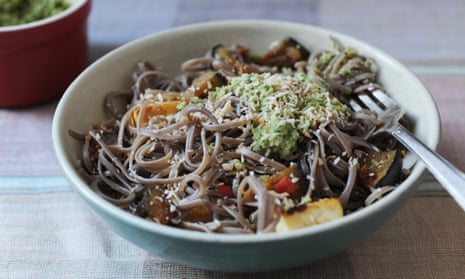I go nuts for coconut, so this week’s theme has turned the supposedly most miserable week of the year into a round-the-world trip of brilliant breakfasts, lunches and dinners. It’s been so difficult to whittle it down, in fact, that I’d suggest going to the GuardianWitness site for a peep at all the entries.
I began with a firm yet syrupy bake from Fadime Tiskaya followed by a gluten-free tropical tart from Cookeathope – so virtuous yet delicious that I consumed a slice most mornings in place of a fruit salad. I don’t think that was the intention, but I can imagine it’d make a great slimline dessert for January entertaining, too. Veggegirl’s fresh coconut chutney was the perfect foil to a spicy vegetable curry, and kept well in the fridge for several days, as did Shan McAnena’s Northern Irish Fifteens, while MizPepperpot’s jerk pork goujons worked well for dinner and stuffed into pitta bread with salad the next day.
But it was the bold flavours in ElleZumbido’s noodles with coconut and coriander pesto that won me over. The vibrancy of ginger, garlic and chilli, crisp tofu, meltingly soft aubergine and zing of coriander were all beautifully balanced with the coarse texture and creamy flavour of desiccated coconut. Even if you don’t cook the whole dish, make this pesto and eat it with pretty much anything.
The winning recipe: Noodles with coconut and coriander pesto
I love to use desiccated coconut in savoury dishes. Here the sweetness and crunchiness of the coconut compliments the salty, earthy flavours of the aubergine and noodles. You can pick up black rice noodles in Asian supermarkets, but use soba noodles if you can’t find them.
ElleZumbido, via GuardianWitness
Serves 4
1aubergine, chopped into 2cm cubes
1tsp salt
250g firm tofu
1½ tbsp raw virgin coconut oil
½ red chilli, deseeded and finely chopped
2 garlic cloves, finely chopped
25mm piece of fresh ginger, peeled and finely chopped
1 tbsp tamari or soy sauce
8 dried makrut lime leaves
250g black rice noodles or soba noodles (I use King Soba)
50g desiccated coconut, toasted, to serve
For the pesto
50g desiccated coconut, toasted
A large bunch coriander, roughly chopped
40g raw virgin coconut oil, melted
¼ red chilli, deseeded and finely chopped
1 garlic clove, finely chopped
Juice of 1 lime
½ tsp salt
½ tsp black pepper
120ml coconut milk
1 Place the aubergine cubes in a colander, sprinkle with the salt and leave for 20 minutes to draw the water out.
2 Meanwhile, drain the tofu by wrapping it in three pieces of kitchen paper and placing it between two chopping boards with something heavy on top for 15 minutes(a book or tin cans would do). This ensures the tofu will crisp up well.
3 To make the pesto, blend the desiccated coconut, coriander, coconut oil, chilli, garlic, lime, salt and pepper together in a food processor with 50ml of the coconut milk. Add the remaining coconut milk bit by bit until you have your desired pesto-like consistency. Set aside.
4 Give the aubergine a quick rinse to remove any excess salt, then heat 1 tbsp of coconut oil in a wok and, once melted, fry the aubergine over a medium/high heat. When it starts to soften and turn golden, add the chilli, garlic and ginger, taking care that they don’t burn. The aubergine is done when it has browned and softened. Before you take it out of the pan, add the tamari, or soy, and stir for a further minute. Remove from the wok and set aside in a large bowl.
5 Cut the tofu into 2cm cubes. Fry over a high heat in ½ tbsp of melted coconut oil, along with the makrut lime leaves, until golden, turning the pieces as you go. Remove the leaves and discard, put the tofu into the same bowl as the aubergine and mix together.
6 Finally, cook the noodles for 4-5 minutes in boiling water until al dente. Rinse with warm water and drain. Combine all of the ingredients and serve in bowls with a dollop of pesto on top and a good sprinkling of toasted desiccated coconut.
Tropical bounty tart
Think healthy, inside-out Bounty bar, with extra tropical flavours!
Cookeathope, via GuardianWitness
Serves 6-8
125g raw virgin solid coconut oil
3-4 tbsp honey
125g desiccated coconut
2 ripe bananas
60g cocoa powder
1 ripe mango, peeled and thinly sliced
2 ripe passionfruit, pulped
1 In a small saucepan, gently melt 50g of oil. Remove from the heat then stir in 1 tbsp honey, then the coconut, and mix well.
2 Using the back of a spoon, press the coconut mix firmly into the base and sides of a 20cm tart tin. Transfer to the fridge to firm up while you make the filling.
3 Gently melt the remaining oil. Puree the bananas and the rest of the honey in a processor. Add the cocoa powder, blitz again, then finally pour in the melted oil and combine. Taste. Add a little more honey, if needed. Spread the chocolate mix on to the coconut and return to the fridge for about 1 hour, or until it has set.
4 Arrange the mango slices on top, and finish with the passionfruit pulp. Cut into slices straight from the fridge, but leave at room temperature for 10 minutes before serving.
Coconut jerked pork goujons
One of the great things about desiccated coconut is that it makes a wonderful, flavourful, crispy coating. And of course it has that tropical thing going on that allows it to go so well with other Caribbean flavours. In this recipe I’ve used the coconut to coat pork strips, which have first been marinated in jerk spices.
MizPepperPot, via GuardianWitness

Serves 4-6
500g pork loin steaks, cut into goujons
4 tbsp jerk marinade
60g dried breadcrumbs
80g desiccated coconut
1 egg, beaten
Oil, for frying
1 Marinate the meat in the marinade for at least one hour or overnight.
2 Mix the breadcrumbs and the coconut together in a large bowl. I haven’t specified what type of crumbs to use as I tend to use leftover stale bread from my freezer. You can make the crumbs extra crispy by drying them out in a warm oven for a few minutes or you could simply buy panko breadcrumbs.
3 Dip the jerk-coated meat in beaten egg, then in the coconut crumbs mix, then either shallow-fry over a medium heat, turning once, for about 5 minutes each side, or bake in in the oven at 190C/375F/gas mark 5, on oiled baking paper for about 15 minutes.
4 Serve with some mango chutney or a cooling, sour cream dip to combat the heat of the jerk seasoning.
Coconut and semolina yoghurt cake with orange syrup
This recipe is based on one of my favourite childhood sweet desserts: deep-fried yoghurt and semolina doughnuts dipped into cold thick syrup.
Fadime Tiskaya, via GuardianWitness

Makes 16 small cakes
120g desiccated coconut
90g semolina
75g plain flour
1½ tsp baking powder
90g unsalted butter, at room temperature
75g caster sugar
2 medium eggs
200g plain yoghurt plus extra to serve
Juice and zest of 1 lemon
For the syrup
180g sugar
250ml water
Juice of 1 orange
2 tbsp lemon juice
2 tbsp orange blossom water
1 First, make the syrup. Gently heat the sugar, water and orange juice in a saucepan until the sugar has dissolved. Bring to the boil. Cook over a medium heat for about 15-20 minutes, until the syrup has reduced by a quarter. Add the lemon juice, take off the heat and stir in the orange blossom water. The syrup is ready if coats the back of a spoon. Set aside and let it cool completely.
2 Preheat the oven to 180C/350F/gas mark 4. Grease a 23cm, deep, square cake tin and set aside.
3 Mix together the coconut, semolina, flour and baking powder then set aside.
4 Using an electric mixer, beat the butter and sugar together for 3-5 minutes until it is fluffy. Add the eggs and whisk for another 2 minutes, then mix in the yoghurt followed by the lemon juice and zest.
5 Fold in the dry ingredients and pour the batter into the tin. Bake for 30 minutes until golden: slide a skewer into the centre of the cake: it should come out clean if it is cooked. When it’s still hot, slice the cake into small squares before you pour over the cold syrup. Serve at room temperature with a dollop of thick plain yoghurt.
Indian coconut chutney
You can serve this fresh chutney with masala dosa or idlis for a south Indian breakfast.
Rachel Demuth, via GuardianWitness
Makes 1 large jar
200g desiccated coconut
4 small green chillies, finely chopped
A large pinch of salt
Water
3 tsp sunflower oil
2 tsp mustard seeds
1 dried red chilli
A few curry leaves
A small handful of fresh coriander, chopped
1 Soak the desiccated coconut in boiling water for 30 minutes, then transfer it to a sieve and allow the water to drain away.
2 Put the coconut, green chillies and salt in a blender, with the motor running add just enough water to blitz the mix into a porridge-like consistency. Decant and set aside.
3 Heat the sunflower oil in a small frying pan and add the mustard seeds, dried chilli and curry leaves. When the mustard seeds pop, stir this mix into the coconut mix. Add the fresh coriander and season to taste.
Fifteens
I’d never heard of these heavenly chilled treats until I moved to Northern Ireland 20-odd years ago. A perfect balance of textures for a serious sugar-hit – great for making with kids and beloved by people of all ages. The clue to the recipe is in the name...
Shan McAnena, via GuardianWitness
Serves 10-14
15 large marshmallows, halved
15 glace cherries, halved
15 digestive biscuits, roughly crushed
150ml condensed milk
75g desiccated coconut
1 Toss together the marshmallows, cherries and biscuits in a large bowl, then gradually add the condensed milk. You are aiming for a soft, moist dough.
2 Spread a generous layer of coconut on a clean, dry surface and turn out the dough. Use your hands to shape and roll it into a sausage shape, making sure it is liberally coated with coconut. Wrap it in a double layer of clingfilm and chill in the fridge for a couple of hours before slicing into discs of your preferred thickness.

Comments (…)
Sign in or create your Guardian account to join the discussion